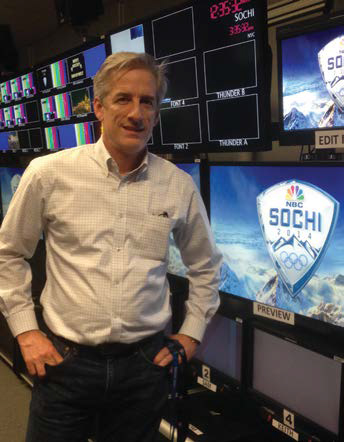From Stamford to Sochi

Mark Hallinger, editor of TV Technology Europe and Asia/Pacific editions, was in Sochi covering NBC for two weeks. He sat down with David Mazza, senior vice president and chief technology officer for NBC Sports Group and NBC Olympics just the before Closing Ceremonies to find out how this latest stop in NBC’s long Olympics journey went.
TV TECHNOLOGY: In the past we’ve talked about Olympics 1.0, 2.0 and so on… what was Sochi?
MAZZA: I think I once told you we were Olympics 2.0; we might have even said we were 3.0. I would say we are more evolutionary now, so we are probably on a ‘point release.’
But the interesting thing is we come out of every games with lessons learned. We come out of every games with a few things we say we’re never going to do that again. And then we adjust accordingly
But then you get to the next games, and some of the conditions are so different, like they were in Russia. A lot of your consistency from one games to the next, when you were perfecting something—it took a whole left turn because you hit a totally new problem that was standing in the way of success. It might have been power stability, construction, logistics or security. In some cases it is as basic as drainage or snow removal in the compounds. Many times the problems are not what you think they are going to be.
It might have been the rodent eating through the cables up at Alpine. The first fibre we ran to the top of the hill, some sort of rodent ate through it in three or four different spots. We had to order new Kevlar-based fiber, which apparently they can still chew through, but they don’t like the taste of it, or the texture. We waited to put that in at the last minute.
TVT: What was the hardest part about this Olympics? Was it the delayed construction?
The professional video industry's #1 source for news, trends and product and tech information. Sign up below.

David MazzaMAZZA: Yes, it was the timelines across the board, and trying to gain access due to logistics and security. The problem is, we’ve refined our schedules over the years… we know exactly how much time is required. And we’ve trimmed and trimmed and trimmed to be more efficient.
We knew we would run into some things, so we did loosen the schedules up. But we probably didn’t loosen it up enough. Having said that, when we finally did get into the International Broadcast Centre, everybody worked at warp speed. And by Christmas, we really were caught up to where we would have normally been. So that meant the month of January went way better than we had been anticipating.
Knowing it was going to be tough on the ground [in Sochi], we did a lot more testing and prefabbing before we left home. And we shipped earlier so we were sure that we could get through customs. The Sony integration guys had been prefabbing a lot of the equipment that we would typically do onsite, and that saved us a tremendous amount of time.
TVT: There were substantially more hours of broadcast coverage this time versus Vancouver (2010). Was staffing—including back home—the same?
MAZZA: As far as cost is concerned, we don’t really count the guys at home the same way, because a lot of them are staff and they’re sleeping at home—so the overall expenses and T&E are lower. Certainly, they are counted when we think about what I call “people per produced hour.” But where the people versus hours equation looks very favorable is with all the digital content; all the new media. Because there’s just far fewer people working on all that, by design, than there are on the big broadcast shows.
It’s obviously consistent with the audience. For Friday’s Opening Ceremonies coverage, 50 million people watched it on TV or cable. But online, I don’t know; I think two million people were watching the hockey game, [and that’s] a really big live stream. The audiences are just very different sizes, and we have to keep the people working on those somewhat consistent with that.
TVT: And the term “new media” you just used has actually been put out to pasture?
MAZZA: Yes, we don’t call it new media now; we call it “digital.” And it’s such a misnomer; everything we’ve done in broadcasting has been digital since 1998. But it wasn’t necessarily digital files; it was digital video.
TVT: This is the first Olympics with the Stamford facility fully operational.
MAZZA: Yes. The amazing thing about that place is that the Stamford construction did not start in earnest until February 2012, and our first studio went on air Dec. 4, 2012. In between those dates we were gone for four months, doing the London Olympics.
TVT: And the Stamford NBC Sports Channel facility is integral to the future?
MAZZA: Yes, it is. What’s kind of cool about this is we built the place to be able to have big parts of it switched back and forth between 50 and 60 Hz reference. Three of the control rooms [in Stamford] and two-thirds of the EVS rooms and the edit system were running 50 Hz. And that saved us a lot of standards conversion until the very final product was ready for transmission.

